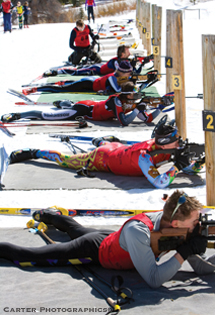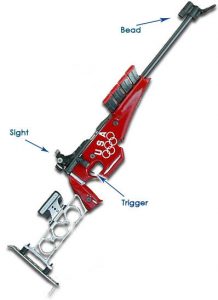HISTORY OF BIATHLON

Many sports are born out of necessity and gradually turn into a form of recreation (the Luge was borrowed from a sledding method of delivery boys, for example). The Biathlon, so named because its Latin translation means “the joining of two contests,” is one such sporting event. The combination of skiing and pausing to shoot a weapon (bow, rifle, or other projectile) goes back to the early days of snow dwellers hunting for food. Such scenes have been found depicted in rock carvings in Norway.
These survival techniques were adapted for use by the Norwegian military and eventually became a source of competition. The first recorded Biathlon race goes all the way back to 1767, in a contest held between the Swedish and Norwegian ski-runner companies. From then on a variety of rifle and ski clubs held informal contests. One such ski club called the “Trysil Rifle and Ski Club” was formed in Norway in 1861 to promote national defense at the local level. At the 1924 Winter Olympics in Chamonix, France the sport was introduced at the games as a demonstration event; however, it was called “Military Patrol” at this time. The event was dropped after World War II due to post-war sensitivities towards the military.
COMPETITION

In 1948, the Union Internationale de Pentathlon Moderne et Biathlon (UIPMB) formed as the international governing body of Biathlon and modern Pentathlon, and Biathlon was accepted as an official Winter Olympic Sport in 1955. The sport was first seen at the Winter Olympics as a medal event in 1960 at the Squaw Valley Winter Olympics. Klas Lestander of Sweden won the gold medal. At this time the Biathlon was contested over 20 km with 20 shots fired over four different ranges: 200m, 250m, 150m and 100m. The first three series were fired from a prone position, the last standing. Each missed target gave a two minute penalty, which was added to the final time. As you’ll read further down this article, the rules have changed a bit.
RULES OF BIATHLON EVENTS
Individual
The 20 km Individual race (15 km for women) is the oldest Biathlon event. The biathlete shoots four times at any shooting lane, in the order of prone, standing, prone, standing, totalling 20 targets. For each missed target a fixed penalty time, usually one minute, is added to the skiing time of the biathlete. Competitors’ starts are staggered, normally by 30 seconds.
Sprint
The sprint is 10 km for men and 7.5 km for women. The biathlete shoots twice at any shooting lane, once prone and once standing, for a total of 10 shots. For each miss, a penalty loop of 150 m must be skied before the race can be continued. As in the Individual competition, the biathletes start in intervals.
Pursuit
In a Pursuit, biathletes’ starts are separated by their time differences from a previous race, most commonly a Sprint. The contestant crossing the finish line first is the winner. The distance is 12.5 km for men and 10 km for women, there are four shooting bouts (two prone, two standing, in that order), and each miss means a penalty loop of 150 m. To prevent awkward and/or dangerous crowding of the skiing loops, and overcapacity at the shooting range, World Cup Pursuits are held with only the 60 top ranking biathletes after the preceding race. The biathletes shoot at the lane corresponding to the position they arrived (Arrive at the range in 5th place, you shoot in lane five.) for all shooting bouts.
Mass start
 In the Mass start, all biathletes start at the same time and the first across the finish line wins. In this 15 km (12.5 km for women) competition, there are four bouts of shooting (two prone, two standing, in that order) with the first shooting bout being at the lane corresponding to your bib (Bib #10 shoots at lane #10 regardless of position in race.) with rest of the shooting bouts being at the lane in the position they arrived (Arrive at the lane in 5th place, you shoot at lane five.). As in Sprint races, competitors must ski one 150 m penalty loop for each miss. Here again, to avoid unwanted congestion, World Cup Mass starts are held with only the 30 top ranking athletes on the start line (half that of the Pursuit since here all contestants start simultaneously).
In the Mass start, all biathletes start at the same time and the first across the finish line wins. In this 15 km (12.5 km for women) competition, there are four bouts of shooting (two prone, two standing, in that order) with the first shooting bout being at the lane corresponding to your bib (Bib #10 shoots at lane #10 regardless of position in race.) with rest of the shooting bouts being at the lane in the position they arrived (Arrive at the lane in 5th place, you shoot at lane five.). As in Sprint races, competitors must ski one 150 m penalty loop for each miss. Here again, to avoid unwanted congestion, World Cup Mass starts are held with only the 30 top ranking athletes on the start line (half that of the Pursuit since here all contestants start simultaneously).
Relay
The Relay teams consist of four biathletes, who each ski 7.5 km (men) or 6 km (women), with two shooting rounds; one prone, one standing. For every round of five targets there are eight bullets available, though the last three can only be single-loaded manually one at a time from spare round holders or bullets deposited by the competitor into trays or onto the mat at the firing line. If after eight bullets there are still misses, one 150 m penalty loop must be taken for each missed target remaining. The first-leg participants start all at the same time, and as in cross-country skiing relays, every athlete of a team must touch the team’s next-leg participant to perform a valid changeover. On the first shooting stage of the first leg, the participant must shoot in the lane corresponding to their bib number (Bib #10 shoots at lane #10 regardless of position in race.), then for the remainder of the relay, the relay team shoots at the lane in the position they arrived (Arrive at the range in 5th place, you shoot at lane five.).
(Rules retrieved from: http://www.biathlon.be/rules.html)
EQUIPMENT AND TRAINING

Biathletes have to possess two different skill sets — accuracy and endurance. It is no easy task to ski at breakneck speed only to stop and accurately shoot a target. Controlled breathing, stamina, and focus are just a few techniques which must be mastered for the Biathlon.
Of course this event also requires a few more piece of equipment than other winter sports. Biathletes must expertly use:
- Skis – The biathlete’s skis are shorter and straighter than typical cross-country skis.
- Lycra suits -The tight suits reduce resistance while skiing and allow free movement. Additional layers can provide warmth.
- Goggles – Biathletes must be sure to select goggles which can easily be moved about when it comes time to shoot.
- Ski poles
- Rifles – In 1978, the .22 caliber rifle became the international standard. Today’s Biathlon rifle uses non-optic sights and straight-pull-bolt action (no full or semi-automatics). The rifles have a specially made lightweight stock, though by international rule they must weigh a minimum of 7.7 pounds. (Taken from HowStuffWorks.)
- Rifle harness – Used to carry the rifle on the back while skiing. There is a protective portion to prevent snow from entering the rifle’s barrel.
- Ammunition – Standard .22 caliber ammunition is used for the Biathlon. It is loaded into magazines which hold five rounds. For the relay race, biathletes may carry an additional three rounds, but those must be placed into the rifle individually as they are needed. The rifle is loaded only at the range.
- Arm sling – For stability biathletes connect a sling to a firing cuff on their arm.
Training for a Biathlon is multi-faceted. First things first — obtain any required licenses for using a firearm. Opt for additional firearm training, if need be. Then you can be on your way. We found a good picture tutorial on training for a biathlon at WikiHow – http://www.wikihow.com/Do-Biathlon.
We hope that now when you watch the Biathlon in the Olympics, you will be a bit more informed about the sport! What do you think — could you handle the stop and go of skiing and shooting?


